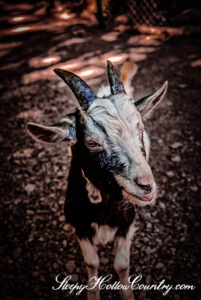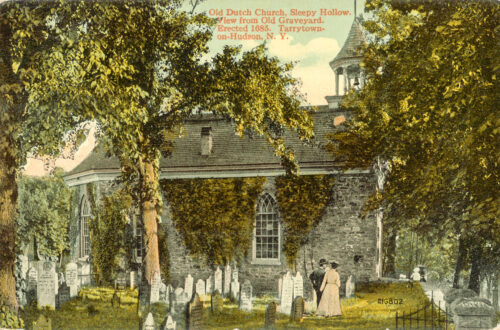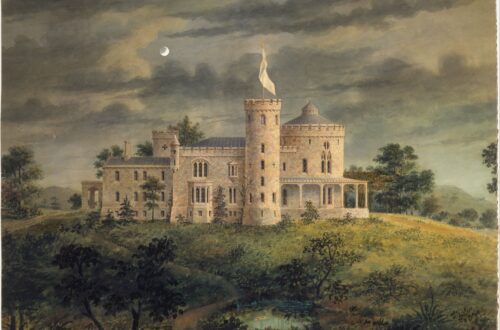
The Obstreperous Tarrytown Goats
In fairness to goats everywhere, Tarrytown goats are not unique in their obstreperousness. They are an unruly animal across the board. However, here in Sleepy Hollow Country we have more than our share of oddities, and our goats are no exception. Make that past tense. At the time of writing, Tarrytown and Sleepy Hollow restrict livestock within village limits. Here are three of our favorite tales of Tarrytown goats.
Tarrytown Goat Sets Monetary Policy
In the late 1800s the United States Congress hotly debated changes to monetary policy. At issue in the “money question” of the day was whether to base American currency on gold or on silver. Further, there was pressure to expand the currency supply to ignite economic expansion countered by fears this would instead unleash devastating price inflation.
In December of 1897 a Tarrytown goat unwittingly gave newspaper editors up and down the Hudson Valley a metaphor for the dithering of Congress. The Argus of Albany, New York reported in its December 12 edition: “A Tarrytown goat last week investigated the money question by swallowing a leather pocketbook containing silver money and a roll of bills; and its owner is in a quandary whether to investigate Billy and possibly lose both money and goat, or accept the situation as it is.”
This was a conundrum worthy of the farmer in Aesop’s fable about the goose that laid the golden eggs. What to do? Kill the goat in attempt to recover the paper bills? Mentally amortize the lost money over the course of the goat’s remaining years? Would the paper money even be intact after its time in the four chambers of a ruminant’s stomach?

The answer came a few days later in the Dobbs Ferry Register. “The curator of the Tarrytown goat which ate up a purse containing a roll of greenbacks shows business talent in declining to have the animal killed on the ground that the recovered bills would not be likely in financial circles to be construed as legal tender. She would thus lose both the goat and the money, and wisely decides to save the former, which is still a valuable domestic asset, though loose and extravagant in its dietary habit, after the manner of its kind.”
How, you ask, did this goat make itself such an expensive lunch? Apparently a Mrs. John Connors of Clinton Street in North Tarrytown (today’s Sleepy Hollow) went out in her yard to talk to a neighbor. Fatefully she left the door open. While the two women chatted, one of Mrs. Connors’s two goats entered the house and ate her pocketbook which was lying on the kitchen table. A newspaper tallied up the damage: “Besides the leather the goat had swallowed a ten-cent piece, a nickel, and a roll of bills containing $10.” Adjusting for inflation, that $10.15 would be worth about $375 today.
It’s a stretch, but you could interpret it to mean this Tarrytown goat favored silver based currency over gold as well as a contraction of the supply of paper money!
Rockefeller the Goat
These days deer, not goats, are the ruminants destroying shrubbery in the backyards and woodlands around Tarrytown and Sleepy Hollow. Back in 1906, however, one large, white goat was the scourge of the expensive plantings on John D. Rockefeller’s vast estate. So fond was he of Rockefeller’s greenery that locals nicknamed the goat “Rockefeller”. Rockefeller’s estate workers were apparently not as amused as the townsfolk. The goat caused such damage they shot it. Twice. The goat survived and thrived.
In February 1906 Rockefeller the goat performed an unusual feat which garnered him national news coverage. Spying a funeral wreath on the verandah of the house of John Beadl, who had died several days prior, the goat climbed on the porch just about the time the funeral was to start. To the horror of the mourners and the undertaker, the goat devoured the wreath, ribbons and even the black funeral crepe.
Not missing a beat, The Detroit Free Press took a swipe at the other Rockefeller, the human oil tycoon: “The undertaker said the goat reminded him of the Oil Trust, which wants to gobble up everything in sight.”
Tarrytown Goat Serves Revenge

In December of 1872, when a train on the New York Central line made a scheduled stop at the Tarrytown station, a porter of one of the drawing-room cars got off the train for a breath of fresh air. Spotting a goat near the station, he gave it a playful kick then started back to the train, which had begun to move.
As The Chicago Evening Mail later reported, “Mr. Goat, unknown to the porter, followed up closely, and at an opportune moment ‘bucked’ in the basement of the pantaloons, giving, at the same time, a cheerful ‘Ba-a-a!’ The porter was knocked head over heels, and before he could get up he got another buck in the same place, followed by another “Ba-a-a!”
By this time the train had moved off. The porter was left with no alternative but to wait for a later train. He didn’t make it back to Troy station until well after midnight. Don’t mess with a Tarrytown goat!




